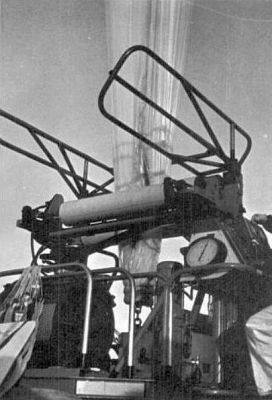Purpose of the flight and payload description
The objective of the flight was to test a new system for launching high altitude plastic balloons directly from the manufacturer's shipping crate. This technique was primarily designed to facilitate the handling, inflation, and launch of large balloons from small ships at sea. The system was developed by the Air Force Cambridge Research Laboratories (AFCRL) between 1961 and 1965.
CONTEXT AND DEVELOPMENT
A ship at sea provides an ideal launch platform for large high altitude plastic balloons. By running with the wind a ship can create a highly desirable "zero wind" condition during the critical stages of balloon inflation and launch. This advantage has led to a history of balloon launches conducted at sea. As balloons and balloon payloads increased in size, however, the problem of obtaining an appropriate launch vessel became more acute. Such a vessel required the speed and maneuverability necessary to negate wind effects, a relatively large deck area to support conventional launch techniques, and an adequate storage area for the lifting gas, flight system hardware, and balloon launch equipment. These requirements limited ship selection to aircraft carriers, which were costly and of limited availability.
In 1961, AFCRL was asked to develop a shipboard launch technique that would circumvent the restrictions of an aircraft carrier while retaining the highly desirable properties of a shipboard launch. In accordance with this request, AFCRL developed the "C" launch technique, a launch method that was designed for operational use aboard small vessels. The need for expansive deck space wass eliminated by inflating and deploying the balloon directly from its shipping crate. A tethering technique was then used to position the balloon directly over the payload, at which time the launch was made.
The realization of this method required the development of a special "launcher" device which you see in the figure at left. Briefly, it was an electro-hydraulic device consisting of a system of rollers through which the balloon was deployed and controlled. Additionally, it had a balloon bottom end fitting tie down and release device, in which was incorporated a free lift sensor and indicator, and a balloon transfer-deployment winch. The model shown measures approximately 7' x 7' x 7' and weighed approximately 2000 pounds.
In addition to concentrating heavily on the launch technique, during the tests were imposed certain other requirements: in order to trouble the Navy as little as possible, the technical teams in charge of the operation worked for minimum loading and unloading times. The result was that within 48 hours all the equipment, from helium trailers and instrument van to balloons, was fully loaded and prepared for sea. Within 24 hours of returning to port the same equipment was unloaded. Another aim was to operate without requiring any permanent modification to the ship.
Despite the fact that the tests of this new launch technique were successful, it finally was never taken to the operational field.
Details of the balloon flight
Balloon launched on: 8/25/1964
Launch site: USS Wood County (LST-1178) frente a la costa de Virginia dentro de la zona de control de la Marina de los EEUU denominada VACAPES
Balloon launched by: Air Force Cambridge Research Laboratories (AFCRL)
Balloon manufacturer/size/composition: Zero Pressure Balloon
End of flight (L for landing time, W for last contact, otherwise termination time): 8/25/1964
External references
- A New High-Altitude Plastic Balloon Launch Method 2nd AFCRL Balloon Symposium, Portsmouth, 1964, Pag. 73
- The "C" launch technique for high-altitude balloons AFCRL, Instrumentation Papers Nº 136, December 1967
2247If you consider this website interesting or useful, you can help me to keep it up and running with a small donation to cover the operational costs. Just the equivalent of the price of a cup of coffee helps a lot.


